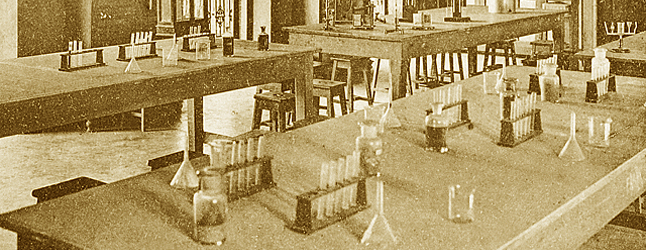

Preamble
In 1964, a gym with change rooms, plus administration area, were added between the former Mountain View School and Revelstoke Secondary School, and the whole converted to RSS. We Grade 8s moved in. On the lower floor were two shiny science labs with rows of raised black counters. We sat at them in pairs, on stools. Each set of students could access a small sink and faucet, electrical outlets, plus a propane outlet. The designers thought to provide the countertops with material resistant to acid and vandals, but I still can’t believe they freely allowed us the ability to set fires, create sparks, and flood the place; for that is what boys are destined to do.
Hari Singh blows up the lab
Mr. Singh (now retired and owner of The Frontier Motel and Restaurant) taught math, chemistry and guidance in those years. This particular day he was at the elevated counter in front of the chem. lab, where all students could easily view demonstrations. He was teaching us how all solids have a combustion point, and that such temperatures vary widely. For example, pure phosphorus has such a low combustion point that it’s self-igniting in air. To keep it stable, it was stored in jars of oil locked in a chemicals room. Mr. Singh brought it out and removed a small piece with tongs and placed it in a beaker of water for safety.
It immediately began to burble, smoke, and skitter on the surface of the water. Suddenly, a narrow, vertical column of material shot up from the beaker. Some of it was water, but within were little balls of smoke that stayed tightly clustered until they got about half a meter into the air. Then they suddenly expanded and coalesced into an ominous mushroom cloud. Mr. Singh dove beneath his desk, and after a startled gasp, the class erupted into screams of laughter. He crept up over the edge of the counter, grinning, and mopping his balding head with a handkerchief.
Bruce Williamson’s stink bomb
“I once tried to get out of writing an exam by carrying out a Mr. Singh chemistry experiment under another teacher’s desk. A sealer jar with nitric acid from the science lab and a couple of pennies from my pocket produced a very stinky gas which made your skin turn orange on contact. The question now is: had know then what I learned later at BCIT, would I have done the prank?
“Copper oxide is an irritant. It also can cause damage to the endocrine and central nervous system. Contact to the eyes can cause irritation and damage to the corneas. Contact to the skin can cause irritation and discoloration. Inhalation can lead to damage to the lungs and septum.” [YIKES, Bruce.]
“The word ‘fink’ was in our vocabulary then, and it was so exercised. Needless to say, I was caught and prosecuted. The windows were opened wide to air the classroom, we still wrote the exam, and I spent 45 minutes in the detention room after school.”
How to make an arc-welder using everyday items
Seems to me it was Larry Stacey and Gordon Jones who invented this one. One Physics 11 class (Omer Payer, teacher), pairs of students were provided with a small transformer with which to study electricity. With it came wires and alligator clips. That year, we boys were also learning to use arc-welders in industrials arts class. Bright minds began to spark, and soon the pair above had rigged a metal ballpoint pen refill as their electrode, and a metal compass case as their table. By turning up the amps on the transformer, they were able to burn a weld across the tin top of their compass box!
Another time, during biology class, two buddies (I’ve forgotten who—guilty parties put your hands up right now) tried something similar. We were doing frog dissections using metal probes with wood handles to tease apart the organs. Conducting their own experiment, one of these guys stuck a probe into the electrical outlet at hand. No shock. So they stuck another into the opposing hole—boring. Then the inevitable dare—lay another probe crossways and see what happens. >KaPOW<—instant arc and weld! Please don’t try this at home, kids.
Alcohol in the classroom
In Grade 11, Gordon Jones graduated from making root beer to red wine. He took part in a group grape purchase with local Italians, and learned to how stomp with the best of them. Best of all, he heard about grappa. Grappa is a brandy made from the grape mash left after juice extraction. Grappa isn’t fermented like wine—it’s a distillate which runs between 37-60% alcohol. At its best, grappa is sold in Italy as a “digestivo”, but at its homemade worst, it’s referred to as “rotgut”, and can be highly toxic. The difference comes in knowledge and operating a safe still.
I will skip the methodology in case young and tender ears are listening. As I recall, some glass tubing, which wasn’t ours, was bent into coils over a handy Bunsen burner. And like a simple arc-welder, the rest of the materials were readily available in any kitchen.
Having successfully conducted taste tests and subsequently losing neither sight nor consciousness, it was clear this extraordinary feat should be publicized. It was a revelation to us boys that booze could be so cheap and so easy to make—particularly because were all under 21, the legal drinking age at that time.
The next thing you know, Gordon is at the head of David Rolston’s Science class, giving a show and tell. The product was illegal, but Mr. Rolston was a wine drinker too, I suppose. The culmination of the demonstration required dimming the lights and drawing the drapes. Gordon held up a spoonful of alcohol and lit it as proof of volatility. It burned blue. Science had freed us once again!
Tom Parkin is widely-published author and Revelstoke Secondary School grad of ’69. He went on to obtain a science degree at UBC, and despite repeated attempts, never successfully blew himself up. He still likes wine.



